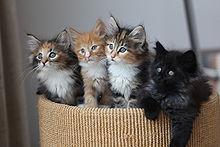Litter (reproduction)

A litter referred to in mammals multiple of a mother animal during pregnancy (by throwing ) born pups . The approximate litter size is typical of the species and can be estimated based on the existing teats .
The number of litters and the litter size are related to the lifespan and ecological factors. High litter sizes are more common in primitive than in specialized species, small species often have larger litter sizes than large species, and in those who flee from the nest , the litter size is usually smaller than that of nestlings .
The number of offspring of a female results from the number of litters and the litter size. Most mammals give birth to young animals several times in their life. A female rarely gives birth once in a lifetime.
In one litter, the position of the fetus in the uterus determines the level of testosterone. For example, individuals lying in the uterus between two male fetuses later have a higher testosterone level than animals lying between two female fetuses. The aggression potential of a mammal is significantly influenced by the testosterone level.
Individual evidence
- ↑ Duden: throw (4). .
- ↑ Rolf Sauermost, Doris Outgoing (ed.) Encyclopedia of biology in fourteen volumes. Fourteenth volume . Spectrum Akademischer Verlag (Elsevier), Heidelberg 2002, ISBN 3-8274-0334-0 (513 pages; “Litter” p. 401).
- ↑ a b Dietrich Starck: Textbook of Special Zoology. Volume II: Vertebrates. Part 5: Mammals . Gustav Fischer Verlag, Jena 1995, ISBN 3-334-60453-5 (1241 pages; pp. 226-227).
- ↑ Kappeler: Behavioral Biology, p.464